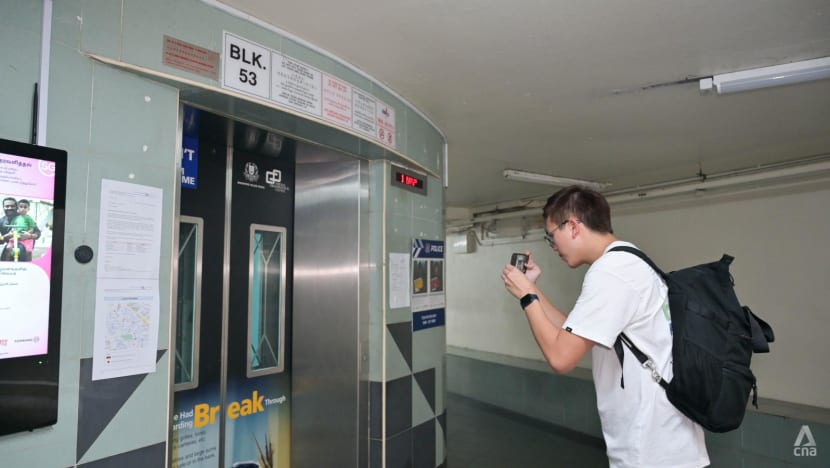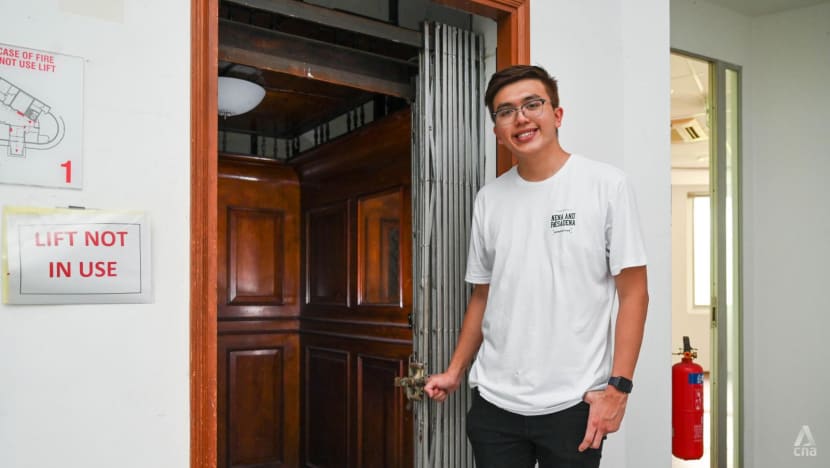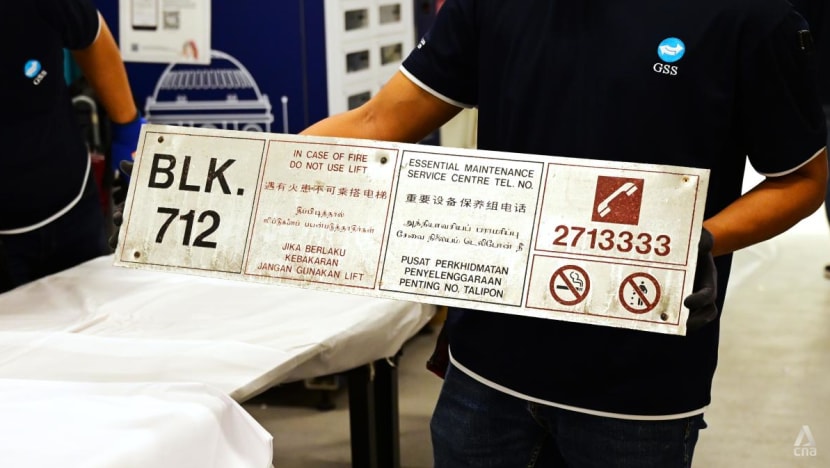'Taken for granted until they disappear': Elevator enthusiasts and their quest to preserve old lifts
The efforts of three lift enthusiasts led to an old elevator in Ang Mo Kio being preserved.

Lift enthusiast Wilson Tan takes photos of a lift at 53 Toa Payoh Lorong 5 on May 8, 2024. (Photo: CNA/Eugene Goh)

This audio is generated by an AI tool.
SINGAPORE: When most of us step into an elevator, we do not give a second thought to the design of its buttons, the speed at which it moves up or down, or how old it is.
But for a group of lift enthusiasts, these are things they pay close attention to.
“For you to see a lift which has no doors, no mirrors, no windows … you feel like you’re going back to your childhood era,” said lift and history enthusiast Wilson Tan.
It is the small details that provide clues to how old a lift is, and this can be anything from the buttons to the harshness of the brakes, said Mr Tan, 23.
While some may view it as an unusual hobby, the social media accounts of lift enthusiasts like Mr Tan – where they film their elevator rides – have garnered millions of views and thousands of followers.
Their passion has also led the authorities to preserve an old lift.
Recently, a group of enthusiasts contacted the National Heritage Board in a bid to preserve a 1970s Housing Board lift in Ang Mo Kio. The authorities listened to their pitch and agreed to their suggestions: They would preserve the lift originally destined for the scrapyard.
But what got these lift enthusiasts into the hobby, and what are their favourite lifts in Singapore?
INTERESTED SINCE THEY WERE CHILDREN
Mr Tan became interested in lifts as a child, and spent many days after school taking an old lift installed at his Housing and Development Board (HDB) block. Back then, the lift, which has since been replaced, used to serve only the first, sixth and 12th floors.
“I liked to just go around the lift just to take it from the first to 12th floor, 12th to sixth and then sixth to first,” said Mr Tan, who is a hospitality and tourism student.
He recalled feeling wistful when the lift, which was installed in the 1970s, was replaced with a newer lift with windows.
It was this sense of wistfulness that led him to rediscover the hobby when he was a teenager. In 2016, he and his friends went to explore the lifts at a block of flats at Dakota Crescent, which was slated to be demolished.
Since then, he has continued to visit old lifts around Singapore, taking photos of them and riding them.
Some of his favourite lifts include an almost 100-year-old lift in Singapore at the former St Andrew's Mission Hospital in Tanjong Pagar, which is currently out of bounds to the public, as well as a lift at the “VIP Block” in Toa Payoh, an HDB block famed for a visit by the late Queen Elizabeth II in 1972.

For fellow enthusiast Essek Chua, his fascination with lifts started at the age of 10, when he first learnt about the speed of lifts in Taiwan’s Taipei 101.
Elevators in the Taipei skyscraper can reach speeds of 1,010m a minute, taking just 37 seconds to go from the fifth floor to the observation deck on the 89th floor.
“That was when I started searching up videos on YouTube of lifts (and) trying to take a more keen interest in cool lifts around me, and where I can find old lifts in Singapore,” said the 19-year-old, a full-time national serviceman.
In 2015, when he was 11, he started to take videos of old lifts around Singapore with his mother’s phone. He eventually set up his own YouTube channel to post these videos.
Other than taking videos of lifts, Mr Chua also likes to collect lift parts such as buttons, control panels and lift signs, often visiting sites where a lift is about to be disassembled and asking the workers for parts.
He estimates he has hundreds of these parts stashed at home, which he is happy to show his friends.
“It’s for my own curiosity and for others who are interested, because I think there are history enthusiasts who would also like to know about lifts and buildings,” he said.
His hobby involves not just visiting lifts and collecting parts, but also researching lift locations and upgrading programmes. He keeps track of these programmes so that he knows when old lifts will be replaced.
When Mr Chua found out earlier this year that an old lift at the Ang Mo Kio town centre would be replaced, he felt a sense of dread, he said.
ON A MISSION TO SAVE AN OLD ANG MO KIO LIFT
The lift was located at Block 712 Ang Mo Kio Avenue 6, a four-storey commercial building. It was installed in 1978 by Fujitec and is believed to be the last of its kind in Singapore, said Mr Tan.
It is particularly special as it has no windows and only one sliding door, reminiscent of the lifts he had taken as a child.
After over 40 years, the lift was to be taken down in March for an upgrading programme.
One night before the scheduled date, Mr Tan went to the block at 1am to take some photos and ride the lift for the last time.
But this wasn't enough for him, and he decided he did not want to see a historic lift dismantled and sent to a scrapyard. Along with Mr Chua and another lift enthusiast, they contacted the National Heritage Board (NHB) in February to make a case to preserve the lift.
“This was really the last chance to preserve a specimen of such a lift, because once it is gone, it is gone for good,” said Mr Chua.
After some meetings with the trio, and further research into the lift, NHB decided to preserve it, much to the delight of the enthusiasts.
“After many weeks of stressing out on the Ang Mo Kio lift and also writing emails and sending texts … we are really very glad that the lift was being preserved,” said Mr Tan. “At least (our) efforts paid off.”

In April, NHB invited the media to see parts of the lift as they were being moved for storage at the National Museum of Singapore.
Senior curator Priscilla Chua said that the preservation of the lift is an example of the museum’s “rapid response” collection process.
This process is part of its Collecting Contemporary Singapore initiative, where the museum responds to events by documenting and acquiring stories, images and objects of historical significance.
In the case of the Ang Mo Kio lift, it was only a matter of days from getting the feedback from Mr Tan to when the museum decided to preserve the lift.
“The curators will assess the historical significance, the social and societal significance, and also the display potential of the object, and how relatable and how resonant the object is to the public and Singaporeans,” said Ms Chua.
While there has not been a decision on where or how the lift will be presented, Mr Tan hopes that it can be made into an interactive display where visitors to the museum can enter the lift to press the buttons and even ride it.

PRESERVING A PART OF SINGAPORE’S HERITAGE
Even with an admittedly niche hobby, many of these enthusiasts have gained a strong social media following, and have even had some of their videos of lifts go viral.
This was the case for YouTuber mailerdiablo, who has over 13,000 subscribers on his channel, and whose most viral video of elevator doors closing has amassed 258,000 views.
Speaking to CNA on the condition of anonymity, he said he started his channel in 2009 to catalogue videos of old lifts in Singapore before they disappeared.
While some of his videos began to gain traction in 2014, his viewership took off during COVID-19.
“As everyone had to stay home, I think it was around that time that my videos might have struck a chord with many viewers,” said the enthusiast, who is in his 30s.
While many enthusiasts focus on land transport like buses and trains, the focus on vertical transport has been gaining traction, he said.
“It reminds people of their lived experience and memories, because (lifts are) something that most people use every day at some point and more often than not, take them for granted until it suddenly disappears,” he said.
Besides Singapore, he has also filmed elevators in other parts of the world such as Tokyo, London, Hong Kong, and Sydney.
While his hobby can take up a lot of time, he has no plans to stop.
“I hope to keep it going so that future generations can get to know and learn what elevators in Singapore used to be in the past.”
As for naysayers who may think the hobby is unusual, Mr Chua had this to say: “Being interested in lifts is a rather niche hobby (but) it really is a meaningful way of occupying my time and helping me understand the past.”
















